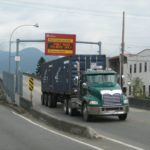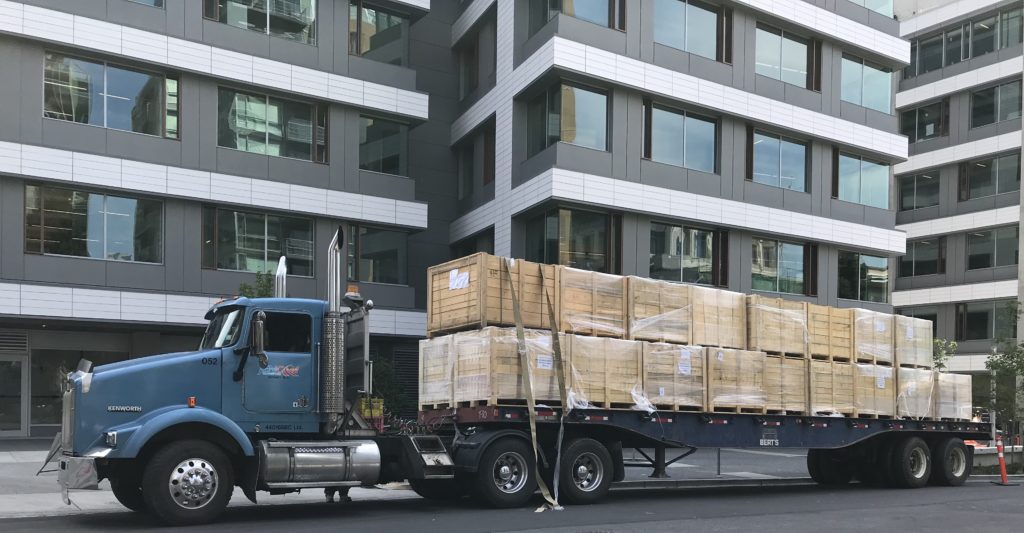Wave Point Consulting’s trucking and road case studies demonstrate efficiency improvements by our transportation economics and planning experts.
Transportation Economist & Planning
Truck Stop Services in British Columbia Market Research (2015-2016)

Transportation economist Philip Davies led this study. Collaborating team members are from Wave Point Consulting, S5 Services, and Site Economics. The BC provincial government wished to explore partnership opportunities and identify locations that would suit the development of comprehensive truck stop services. The scope of work included describing this industry’s growth potential within BC; identify the most promising locations for private sector development and explore the pros and cons of different partnership models. The transportation planning project methodology required the use of both qualitative and quantitative analysis to: define the critical service requirements, develop an industry and growth profile, assessment of current services, identification of high priority locations, business case model and development of policy options.
Highway 97, Peachland Socio-Economic Impact Assessment (2014)
 Philip Davies led this study in collaboration with Site Economic and the IBI Group. Darryl Anderson of Wave Point Consulting Ltd. participated in this project as an Associate of Davies Transportation Consulting. Business Issue: the consulting team will undertake a socio-economic assessment of two distinct alternatives for a four-lane upgrade of Highway 97 through Peachland: (a) Upgrade online of the existing Highway to four lanes; and (b) Construction of a new, four-lane highway bypass alignment. The Ministry of Transportation and Infrastructure had an interest in determining the social and economic impacts of this route choice option. The transportation planning focus was on determining the anticipated outcomes and impacts to local residences, businesses and the economy related to the choice of an online upgrade versus a bypass. The scope of the project provided context and quantification on the route choice option regarding anticipated social and economic impacts over the short, medium and long-term perspectives. The information resulting from the consulting team’s analysis will be used to supplement future benefit-cost analysis in a multiple account evaluation framework. The output from this present study was used to support the social and economic accounts in this future evaluation.
Philip Davies led this study in collaboration with Site Economic and the IBI Group. Darryl Anderson of Wave Point Consulting Ltd. participated in this project as an Associate of Davies Transportation Consulting. Business Issue: the consulting team will undertake a socio-economic assessment of two distinct alternatives for a four-lane upgrade of Highway 97 through Peachland: (a) Upgrade online of the existing Highway to four lanes; and (b) Construction of a new, four-lane highway bypass alignment. The Ministry of Transportation and Infrastructure had an interest in determining the social and economic impacts of this route choice option. The transportation planning focus was on determining the anticipated outcomes and impacts to local residences, businesses and the economy related to the choice of an online upgrade versus a bypass. The scope of the project provided context and quantification on the route choice option regarding anticipated social and economic impacts over the short, medium and long-term perspectives. The information resulting from the consulting team’s analysis will be used to supplement future benefit-cost analysis in a multiple account evaluation framework. The output from this present study was used to support the social and economic accounts in this future evaluation.
Labour Force Profile of Port Drayage Drivers in Metro Vancouver (2012-2013)
 The Asia Pacific Gateway Skills Table partnered with the British Columbia Trucking Association (BCTA) to engage the services of a transportation consultant to undertake an intercept survey and data analysis. The research objective was to provide labour market insights to industry stakeholders, including industry associations, training institutions, and government, that will help inform and guide future initiatives in the drayage sector. In this Davies Transportation Consulting led project Mr. Anderson had a vital role in gathering information, survey pre-testing, stakeholder communications, and analysis. R.A. Malatest and Associates Ltd. (RAM) was the project partner undertaking the surveys.
The Asia Pacific Gateway Skills Table partnered with the British Columbia Trucking Association (BCTA) to engage the services of a transportation consultant to undertake an intercept survey and data analysis. The research objective was to provide labour market insights to industry stakeholders, including industry associations, training institutions, and government, that will help inform and guide future initiatives in the drayage sector. In this Davies Transportation Consulting led project Mr. Anderson had a vital role in gathering information, survey pre-testing, stakeholder communications, and analysis. R.A. Malatest and Associates Ltd. (RAM) was the project partner undertaking the surveys.
Highway Maintenance Market Area Review (2011)
 Philip Davies led this road and highway study for the BC Ministry of Transportation and Infrastructure in cooperation with Darryl Anderson of Wave Point Consulting Ltd. Steve Hayto of S5 Services and Aaron Licker HB Lanarc. Mr. Anderson was a Senior Transportation Consultant, who had a key role economic analysis, comparison of the BC system with other relevant jurisdictions, and gathering information through research and stakeholder interviews. Business Issue: the purpose of the study was to evaluate the structure of the highway maintenance market; identify options for improving efficiency through minimizing costs while maintaining service quality under a private sector delivery model, and maintaining competition in the industry.
Philip Davies led this road and highway study for the BC Ministry of Transportation and Infrastructure in cooperation with Darryl Anderson of Wave Point Consulting Ltd. Steve Hayto of S5 Services and Aaron Licker HB Lanarc. Mr. Anderson was a Senior Transportation Consultant, who had a key role economic analysis, comparison of the BC system with other relevant jurisdictions, and gathering information through research and stakeholder interviews. Business Issue: the purpose of the study was to evaluate the structure of the highway maintenance market; identify options for improving efficiency through minimizing costs while maintaining service quality under a private sector delivery model, and maintaining competition in the industry.
Highway 3 Economic Impact Study (2011)
 Transportation economist Philip Davies led this road and highway study for the BC Ministry of Transportation and Infrastructure in cooperation with Darryl Anderson of Wave Point Consulting Ltd. and Steve Hayto of S5 Services. Mr. Anderson played a crucial role in the analysis of the tourism sector, including gathering information, stakeholder communications, developing the structure and preparation of the market analysis. Business Issue: provide expert advice and analysis related to assessing the industrial and land tourism related passenger related economic opportunities and impacts along the corridor. The transportation planning study scope included two major components: assessment of current and future economic opportunities within the economic catchment areas of Highway 3, 3A and 3B corridors; and assessment of the economic impacts of a proposed package of highway corridor investments based on projects suggested by the Mayors and Chairs Coalition. The Highway 3 Corridor traverses the Southern Interior of BC for approximately 840 km between Hope and the Alberta border. The study also includes sections of Highway 3A and 3B for a total length of approximately 1,120 km. Economic opportunities were assessed through the development of detailed economic profiles of the communities along the corridor, including a detailed GIS-based analysis of employment by North American Industry Classification System (NAICS) categories. Additional analysis was undertaken for major industries, including mining, forest products, and tourism. The assessment of economic impacts of proposed highway investments included estimation of direct user benefits and a scenario analysis based on induced increases in tourism traffic.
Transportation economist Philip Davies led this road and highway study for the BC Ministry of Transportation and Infrastructure in cooperation with Darryl Anderson of Wave Point Consulting Ltd. and Steve Hayto of S5 Services. Mr. Anderson played a crucial role in the analysis of the tourism sector, including gathering information, stakeholder communications, developing the structure and preparation of the market analysis. Business Issue: provide expert advice and analysis related to assessing the industrial and land tourism related passenger related economic opportunities and impacts along the corridor. The transportation planning study scope included two major components: assessment of current and future economic opportunities within the economic catchment areas of Highway 3, 3A and 3B corridors; and assessment of the economic impacts of a proposed package of highway corridor investments based on projects suggested by the Mayors and Chairs Coalition. The Highway 3 Corridor traverses the Southern Interior of BC for approximately 840 km between Hope and the Alberta border. The study also includes sections of Highway 3A and 3B for a total length of approximately 1,120 km. Economic opportunities were assessed through the development of detailed economic profiles of the communities along the corridor, including a detailed GIS-based analysis of employment by North American Industry Classification System (NAICS) categories. Additional analysis was undertaken for major industries, including mining, forest products, and tourism. The assessment of economic impacts of proposed highway investments included estimation of direct user benefits and a scenario analysis based on induced increases in tourism traffic.
Long Combination Vehicle Usage – Freight, Energy, Road Infrastructure, & Safety Outcomes (2004)
 John Woodrooffe, Lloyd Ash, and Darryl Anderson prepared a transportation economics paper based on the research results of an Alberta Transportation initiated a study of data from the period 1995 to 1998. Business Issue: the paper discusses how the use of Long Combination Vehicles (LCVs), operating under special permit conditions, produce some positive economic and safety benefits when compared to semi-trailer trucks. An activity based truck operations and costing model was the research methodology deployed to analyze the freight, energy, and road infrastructure outcomes. Truck safety outcomes were determined by calculating the collision exposure rates based on vehicle distance traveled. The research findings quantitatively demonstrate the extent to which LCV usage in freight transport improves efficiency by reducing the truck trips required on the highway system. LCV usage, therefore, resulted in reduced energy/fuel consumption, less accumulative damage to pavement surfaces. The research findings also reveal that LCVs had the lowest collision exposure rate. Also, the John Woodrooffe led the same team in preparing the paper ‘The Influence of Policy on Crash Rates of Long Combination Vehicles’ at the 8th International Symposium on Heavy Vehicle Weights and Dimensions. The paper was short-listed for consideration for the best paper award.
John Woodrooffe, Lloyd Ash, and Darryl Anderson prepared a transportation economics paper based on the research results of an Alberta Transportation initiated a study of data from the period 1995 to 1998. Business Issue: the paper discusses how the use of Long Combination Vehicles (LCVs), operating under special permit conditions, produce some positive economic and safety benefits when compared to semi-trailer trucks. An activity based truck operations and costing model was the research methodology deployed to analyze the freight, energy, and road infrastructure outcomes. Truck safety outcomes were determined by calculating the collision exposure rates based on vehicle distance traveled. The research findings quantitatively demonstrate the extent to which LCV usage in freight transport improves efficiency by reducing the truck trips required on the highway system. LCV usage, therefore, resulted in reduced energy/fuel consumption, less accumulative damage to pavement surfaces. The research findings also reveal that LCVs had the lowest collision exposure rate. Also, the John Woodrooffe led the same team in preparing the paper ‘The Influence of Policy on Crash Rates of Long Combination Vehicles’ at the 8th International Symposium on Heavy Vehicle Weights and Dimensions. The paper was short-listed for consideration for the best paper award.

